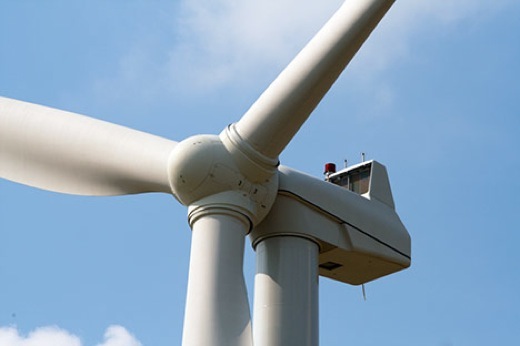SUBHEAD: Wind power eletcrical generation is now a quarter of new plant generation.
By Michael Graham Carroll on 18 July 2011 for TreeHugger -
(http://www.treehugger.com/files/2011/07/wind-power-25-percent-new-electricity-capacity-usa-2010.php)

Image above: Wind powered electric generator. From orivginal article.
The U.S. Department of Energy (DOE) has announced the numbers for wind power in 2010, and there are two ways to look at it. The glass-is-half-empty version is that the amount of new wind power capacity as a percentage of the total new generation capacity went down to 25%, from 42% in 2009 and 43% in 2008. That's quite bad, especially since coal is way up. But there's a glass-half-full way to look at it...


The other - more optimistic - way to look at it is as a delayed, temporary bump in the road caused by the global recession of 2008-2009. Indeed, there's a lag between the day when a wind farm project is approved and financed and when it actually gets built and connected to the power grid. The two very good years in 2008-2009 were this good because of projects that were started during the previous years.
But in the end, what matters is the overall trajectory of the curve, and it is pretty good. It wasn't so long ago that wind power in the U.S. was almost within the margin of error.
The DOE had this to say about wind power in the U.S. in 2010:
By Michael Graham Carroll on 18 July 2011 for TreeHugger -
(http://www.treehugger.com/files/2011/07/wind-power-25-percent-new-electricity-capacity-usa-2010.php)

Image above: Wind powered electric generator. From orivginal article.
The U.S. Department of Energy (DOE) has announced the numbers for wind power in 2010, and there are two ways to look at it. The glass-is-half-empty version is that the amount of new wind power capacity as a percentage of the total new generation capacity went down to 25%, from 42% in 2009 and 43% in 2008. That's quite bad, especially since coal is way up. But there's a glass-half-full way to look at it...


The other - more optimistic - way to look at it is as a delayed, temporary bump in the road caused by the global recession of 2008-2009. Indeed, there's a lag between the day when a wind farm project is approved and financed and when it actually gets built and connected to the power grid. The two very good years in 2008-2009 were this good because of projects that were started during the previous years.
But in the end, what matters is the overall trajectory of the curve, and it is pretty good. It wasn't so long ago that wind power in the U.S. was almost within the margin of error.
The DOE had this to say about wind power in the U.S. in 2010:
Wind power has recently represented one of the largest new sources of electric capacity additions in the United States, though a considerable drop in wind energy's contribution occurred in 2010. Breaking a streak of five years in which wind power was the second-largest new resource added to the U.S. electrical grid in terms of aggregate gross capacity, in 2010 wind power placed third, behind the 7,200 MW of new natural gas and 6,000 MW of new coal-fired generation capacity. 5 New wind power projects contributed roughly 25% of the new nameplate capacity added to the U.S. electrical grid in 2010, compared to 42% in 2009, 43% in 2008, 34% in 2007, 18% in 2006, 12% in 2005, and less than 4% from 2000 through 2004.
No comments :
Post a Comment